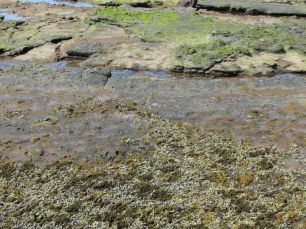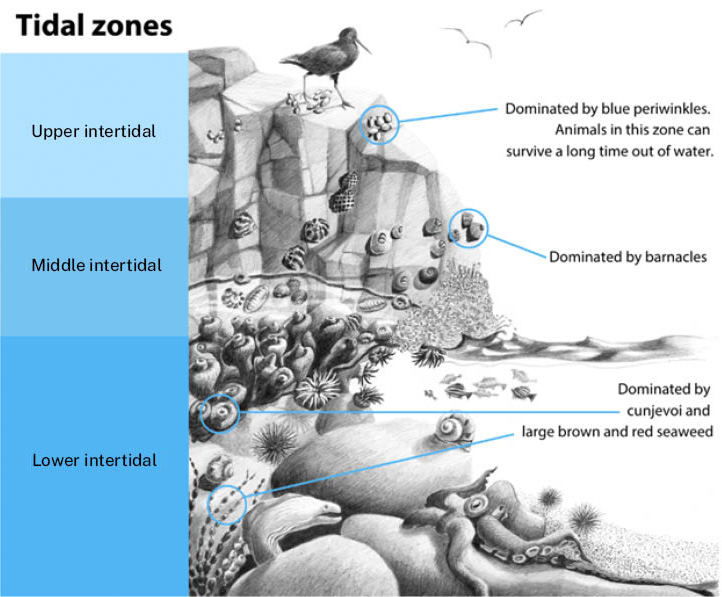
Ecology
Ecology is the science of living things, the environment and their interactions with each other. You can see this in action at Long Reef.
Intertidal zones, exposure to waves and patchy habitats

Intertidal rocky shores have a variety of habitats which are created by a combination of geology, exposure to waves and the slope of the shore.
The type of habitat affects what animals and plants live there.
Long Reef is a great example of a rocky shore that has a wide range of habitats and therefore a wide variety of animals and plants.
Geology
Long Reef Aquatic Reserve includes a vast intertidal rocky reef and some sandy beach.
The oldest rock outcrops are over 230 million years old. Long Reef is rare in the Sydney region because of its chocolate shales, claystones and ironstones which give the area and the water a reddish appearance.
The softer rock, like sandstone, erodes easily, forming rockpools, crevices, hollows, cracks and boulders that become habitats for plants and animals.
Harder rock forms flat areas where many animals feed during high tide and low tide.
Exposure to waves
Long Reef has areas exposed to large waves and also more sheltered areas.
Where medium to large waves reach the shore:
- seaweeds usually have large fronds (leaves) and a firm hold on the rocks (called holdfasts) to withstand the force of the waves.
- animals will be good at:
- finding shelter quickly (e.g. crabs and octopuses)
- holding on, such as those with a large foot (e.g. limpets)
- attaching permanently to the rock (e.g. cunjevoi and barnacles).
In sheltered areas where the waves are smaller:
- the seaweed form crusts that look like different coloured leathery rock
- there are leafy and stringy types of seaweed in rockpools and crevices that stay wet during low tide
- there are lots of snails, small crabs and barnacles.
Slope of the seashore
The slope of a rocky shore creates zones based on the length of time the slope is covered by the tide. The higher up the slope the more time it’s out of water.
These zones are called intertidal zones and animals and plants living here must survive temporary exposure to the air and sun, varying salinity and the forces of breaking waves.
Intertidal zones
The intertidal zone is further split into three zones – upper, middle and lower – based on the length of time the shore is covered by the tide.
In the upper zone, animals are out of water for the longest time and so must handle dry conditions, high salinity, and low to high temperatures – for example, blue periwinkles and crabs.
In the middle zone, animals and plants must also cope with these changing conditions but they are out of water for less time.
Marine life includes barnacles, limpets, snails, crabs, worms, and green and brown algae. Rockpools in this zone retain water when the tide is out providing better protection for anemones, chitons, nudibranchs, sea stars and sea urchins.
The lower zone is covered by water most of the time. Marine life includes cunjevoi, red, green and brown algae, sea urchins, large snails, sponges, anemones, chitons, crabs and nudibranchs.
The area beneath the tide – the subtidal zone – has extensive kelp beds where leafy sea dragons, wobbegongs, blue gropers and giant cuttlefish can be found.
Intertidal habitats in Long Reef Aquatic Reserve include beaches and the various habitats found on rocky shores.
In the steep areas at Long Reef it is easy to see the different zones. In other areas, there are no strong zones but a mix of flat bare areas and patches of different animals and plants.

Different habitats
Rocky shore habitats are created by a combination of geology, exposure to waves and the slope of the shore.
The shore at Long Reef includes cliffs, boulder fields, cobbles and rock platforms with rockpools, cracks, crevices and hollows.
This wide range of features provide different habitats where animals and plants live.

Rock Pools
Rockpools can be very shallow, from less than 5cm deep to being a 1m or more.They contain snails that graze on seaweed, carnivorous snails that eat other snails and barnacles, starfish, sea anemones, crabs, small fish and sometimes octopus.Long Reef has lots of different rock pools.
Deep rock pool. Image courtesy Peter Mitchell

Neptune’s necklace
Neptune’s necklace (Hormosira banksii) is a brown seaweed that looks like a string of beads.They can form large beds in flat areas of the middle littoral zones that remain moist most of the time.They provide shelter for a large variety of snails and small crabs during low tide.There are large areas of Neptune’s necklace providing habitat at Long Reef.
Neptune’s necklace beds at low-tide. Image courtesy Peter Mitchell

Crevices and cracks
Crevices and cracks are gaps between slabs of rock which can occur anywhere on a rocky shore.The animals and plants found here vary depending on where they are on the shore.When the tide is out, animals may congregate in a crevice to retain moisture and then move away from the crevice when the tide is in.Long Reef’s rock platform has many crevices and cracks for animals to hide in.
Striped-mouth conniwinks (Bembecium nanum) hiding in a crevice. Image courtesy Peter Mitchell

Hollows
Hollows are curved depressions in rocks usually very low on the shore and exposed to waves.These are created by sea urchins gradually wearing away the rock with their spines as they cling to the rock while resting.Where many of these hollows occur together, they are called ‘sea urchin apartments.Sea urchins usually leave these hollows at night and graze on the surrounding flat rocks covered by the sea.Long Reef has a great example of sea urchin apartments.
Sea urchin apartments. Image courtesy Peter Mitchell

Flat rocky areas
Flat rocky areas that exist between rockpools, crevices and boulders appear to have no seaweed.In fact, they are covered with microalgae, tiny plants naked to the human eye.These plants are a vital source of food for many snails and starfish and these animals will crawl over the flat areas during mid-low tide and high tide or during rain to feed.Long Reef has large areas of flat rocky shore.
Flat rocky areas. Image courtesy Peter Mitchell

Boulders
Boulders are medium to large rocks that are heavy enough not to be moved by small to moderate waves.They are usually found in more sheltered areas.The underside of boulders house an enormous variety of animals and plants such as sponges, tube worms, colonial sea squirts, chitons, blue-ringed octopus, snails, barnacles and sea anemones.Some of these animals are not found in other habitats.Long Reef has an extensive boulder field.
'Halo' of animals around a boulder. Image courtesy Peter Mitchellt

